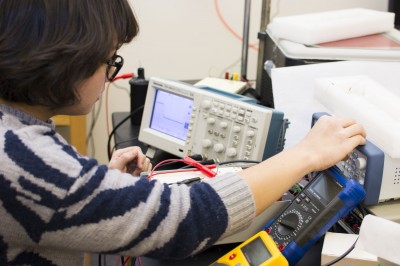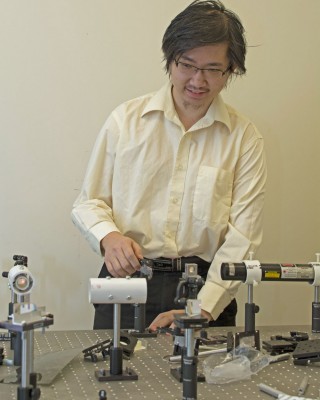By Thao Nguyen '15
For eighteen days (plus some weekends) five physics majors immersed themselves in senior research projects ranging from next-generation batteries to quantum teleportation during their advanced physics lab course.

Interested in pursuing a masters degree in chemical engineering, senior Theint Aung successfully built graphene-based supercapacitors that stored 300 times as much energy as normal capacitors. “This is the future of the energy storage device market in the next five years," she shared excitedly.
Electronic devices such as phones, laptops, and even cars could use supercapacitors as better alternatives to batteries because they charge in seconds, hold their charge for a long time, and are environmentally friendly. Researchers are currently working to make supercapacitors smaller and less expensive.
This project was a perfect combination of Aung’s two majors, chemistry and physics, since half of her work involved synthesizing graphite oxide as the material for the supercapacitor. “You have to be creative and think outside of the box”, she said, noting that she substituted a $50 UV lamp that was normally used for nail polishing for an expensive piece of equipment used in research labs.
More interested in classical physics, seniors Nikki Thompson and Nathan Wichman teamed up to construct a Foucault pendulum to illustrate the Earth’s rotation and measure latitude. “I approach this project in thinking how you would explain it to people who do not understand physics," said Thompson, who wants to be a high school physics teacher.
Senior Philip Han, a double major in physics and philosophy, built a three-qubits (quantum bits) optical system where information can be sent from one place to another without traveling the physical space in between, using the principle of quantum teleportation that may one day pave the way for quantum computing. Senior Jeremias Castaneda, interested in the energy field, built a radio that obtained its power directly from radio waves rather than from a battery.

According to Professor Derin Sherman, “this class is a good representation of working in academia and industry because of its intense pressure.” Pressure, however, turned out to be the Cornell students’ best friend in an environment that mirrored the work day of professional researchers.
“I give this project 100 percent of my attention,” said Aung. “My day starts at 9 a.m. and goes until 6 p.m. every day, including some weekends. It is a test of motivation and responsibility. Professor Sherman allows you to work at your schedule, but you must be driven to get things done.”
“I live and breathe with my project," Thompson added. "The block plan allows me to think about this [project] all the time without being distracted by other things.”